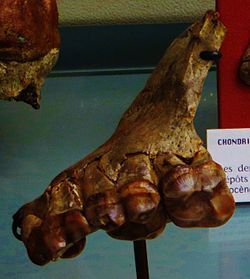Agriotheriinae
|
Agriotherium Temporal range: Late Miocene–Gelasian |
|
|---|---|
 |
|
| Teeth | |
| Scientific classification | |
| Kingdom: | Animalia |
| Phylum: | Chordata |
| Class: | Mammalia |
| Order: | Carnivora |
| Superfamily: | Arctoidea |
| Family: | Ursidae |
| Subfamily: |
†Agriotheriinae Kretzoi, 1929 |
| Genus: |
†Agriotherium Wagner, 1837 |
| Type species | |
| †Agriotherium sivalensis Falconer & Cautley, 1836 |
|
| Species | |
|
†A. myanmarensis (Ogino et al., 2011) |
|
†A. myanmarensis (Ogino et al., 2011)
†A. insigne (Gervais, 1859)
†A. inexpetans (Qiu et al., 1991)
†A. palaeindicus (Lydekker, 1878)
†A. sivalensis (Falconer & Cautley, 1836)
†A. africanum (Hendey, 1972)
†A. coffeyi (Dalquest, 1986)
†A. gregoryi (Frick, 1926)
†A. schneideri (Sellards, 1916)
Agriotherium is an extinct genus of bear whose fossils are found Miocene through -aged strata of North America, Europe, Africa, and Asia, living from ~13.6–2.5 Ma, existing for approximately 11.1 million years. Materials of the late surviving A. africanum from Africa has suggested that A. africanum died out soon during the early Gelasian.
Agriotherium was about 2.7 metres (9 ft) in body length and weighed around 652.6 kg (1,440 lb), making it larger than most living bears. Except for the extinct subspecies of modern polar bear Ursus maritimus tyrannus and Arctotherium, Agriotherium was along with the short-faced bear, Arctodus simus the largest member of terrestrial Carnivora. It had dog-like crushing teeth. Its primary diet was carnivorous and secondary was omnivorous possibly classifying this animal as mesocarnivore. With a body mass close to those of most large ungulates (bovines, cervids, camelids, and others), it is probable that Agrotherium could have preyed on these.
Two specimens were examined by Legendre and Roth for body mass.
...
Wikipedia
